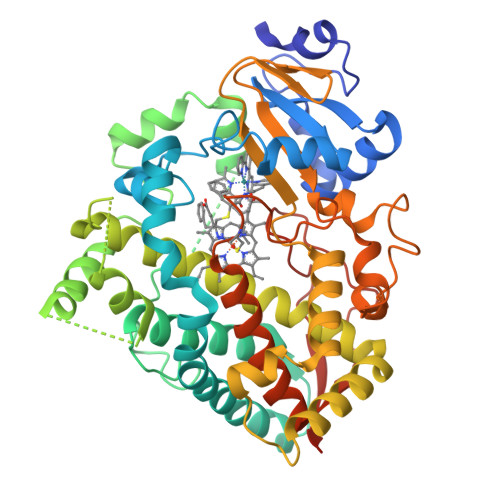Photosensitive Ru(II) Complexes as Inhibitors of the Major Human Drug Metabolizing Enzyme CYP3A4.
Toupin, N., Steinke, S.J., Nadella, S., Li, A., Rohrabaugh Jr., T.N., Samuels, E.R., Turro, C., Sevrioukova, I.F., Kodanko, J.J.(2021) J Am Chem Soc 143: 9191-9205
- PubMed: 34110801
- DOI: https://doi.org/10.1021/jacs.1c04155
- Primary Citation of Related Structures:
7KS8, 7KSA - PubMed Abstract:
We report the synthesis and photochemical and biological characterization of the first selective and potent metal-based inhibitors of cytochrome P450 3A4 (CYP3A4), the major human drug metabolizing enzyme. Five Ru(II)-based derivatives were prepared from two analogs of the CYP3A4 inhibitor ritonavir, 4 and 6 : [Ru(tpy)(L)( 6 )]Cl 2 (tpy = 2,2':6',2″-terpyridine) with L = 6,6'-dimethyl-2,2'-bipyridine (Me 2 bpy; 8 ), dimethylbenzo[ i ]dipyrido[3,2- a :2',3'- c ]phenazine (Me 2 dppn; 10 ) and 3,6-dimethyl-10,15-diphenylbenzo[ i ]dipyrido[3,2- a :2',3'- c ]phenazine (Me 2 Ph 2 dppn; 11 ), [Ru(tpy)(Me 2 bpy)( 4 )]Cl 2 ( 7 ) and [Ru(tpy)(Me 2 dppn)( 4 )]Cl 2 ( 9 ). Photochemical release of 4 or 6 from 7 - 11 was demonstrated, and the spectrophotometric evaluation of 7 showed that it behaves similarly to free 4 (type II heme ligation) after irradiation with visible light but not in the dark. Unexpectedly, the intact Ru(II) complexes 7 and 8 were found to inhibit CYP3A4 potently and specifically through direct binding to the active site without heme ligation. Caged inhibitors 9 - 11 showed dual action properties by combining photoactivated dissociation of 4 or 6 with efficient 1 O 2 production. In prostate adenocarcinoma DU-145 cells, compound 9 had the best synergistic effect with vinblastine, the anticancer drug primarily metabolized by CYP3A4 in vivo . Thus, our study establishes a new paradigm in CYP inhibition using metalated complexes and suggests possible utilization of photoactive CYP3A4 inhibitory compounds in clinical applications, such as enhancement of therapeutic efficacy of anticancer drugs.
Organizational Affiliation:
Department of Chemistry, Wayne State University, 5101 Cass Avenue, Detroit, Michigan 48202, United States.


















